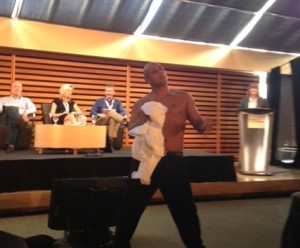The secret to successful branded entertainment is putting the consumer in the centre.
That was the consensus of the Branding Entertainment panel at the inaugural Playback Summit, comprised of Capital C partner and CEO Tony Chapman, CEO of Starcom Mediavest Group Bruce Neve and Bell Media Digital senior director of content, Jon Taylor.
The panel agreed that personal agendas should take a backseat – especially in the branded content battle of egos between networks, agencies and content creators.
“The new reality is that there’s a need for multiple brand stories that can and should be told dynamically across multiple channels,” said Starcom’s Neve. “Consumers are looking for active consumption, and they’re looking for brands to always be on – 365 days a year.”
And to fill that gap, he continued, branded entertainment needs to be an additive and expanding story from the client, versus a repetitive, single idea constantly hammered at the consumer.
“The one word that connects everyone in this industry is engagement. Engagement is our oxygen,” said Capital C’s Chapman.
“The only way to approach this intelligently is to put the consumer at the centre,” he insisted.
And to make headway in the complex landscape that now includes social media marketing and digital ad integration, networks, agencies and content creators need to work together to create and feed their “content engine.”
“If it’s done well, people are blind to the difference between entertainment and [branded] content,” Neve continued, adding, “The consumer can accelerate or vaporize content.”
A challenge lies in navigating the different objectives of the three big players involved in creating branded content, which Bell Media’s Taylor says is starting to level out as they figure out the unit of play.
“The relationship between the three egos is the critical part,” said Taylor.
“[Producers’] measurement of success is the audience and ratings and quality TV. The brand has a different measurement of success. Another challenge is the…pre-existing relationships that a broadcaster has with producers, with agencies and also with clients. Now you have them all in a triangle, and it gets messy [about] who owns which relationship. Broadcasters need to be participants in agency-client relationships,” he added.
But there isn’t a tried and true model established for collaborating on creating branded content, the panel agreed – especially in a time where emerging platforms and consumer demands are leading to changing roles for networks, agencies and producers, as moderator and Marblemedia partner and exec producer Mark Bishop pointed out.
“Who has influence and authority changes by the moment. The brand has a cheque to write, the network has viewers they’re offering, and the producer has the integrity of the story they want to protect,” said Chapman.
Citing Temple Street’s Recipe to Riches (the Loblaw-sponsored competitive food series that aired on Food Network), which was picked up as a format by FremantleMedia in the U.S., as a branded entertainment success story, Chapman noted earlier in the discussion that there’s an opportunity for the Canadian industry to perfect a model here, in producing great content that can get sold internationally.
The bottom line is to start with consumer engagement to build up a model that works, the panel agreed.
“Because it is a brand new model, if you can’t get it focused on engaging the viewer with great content, as soon as you take the focus off of that and it becomes my agenda versus your agenda, it becomes a bad bowl of spaghetti,” said Chapman.
Yesterday’s Summit came to a close with a Dragons’ Den-style Marketing Pitch Competition that had communications consultant, Lauren Richards, along with Rebecca Shropshire, VP, director of digital communications, UM Canada; Ted Boyd, CEO and partner, 58ninety; and Stephen Jurisic, creative director, John St on the judges panel. Three project pitchers had their marketing plans judged.
First, David Heath proposed a marketing plan that included a TV festival around a drama show as well as leaf bags bearing the show star’s image.
Second on the platform, Elize Morgan pitched a show which aims to tap into the alternative reality game market of 20- to 40-year-olds, “nerdcore” enthusiasts aged 18 to 49, and history buffs, which she said tend to be women aged 15 to 30.
Last, and certainly not least, Mark Montefiore livened up the afternoon crowd with a cast of male strippers to pitch an R-rated comedy based on the occupation, targeting Collegehumour.com-loving 18- to 34-year-old males.
The panel picked Montefiore as the winner, with Jurisic saying he would like John St. to be the agency behind the project.
Top right photo: L-R Tony Chapman, Jon Taylor, Bruce Neve
From Playback Daily























